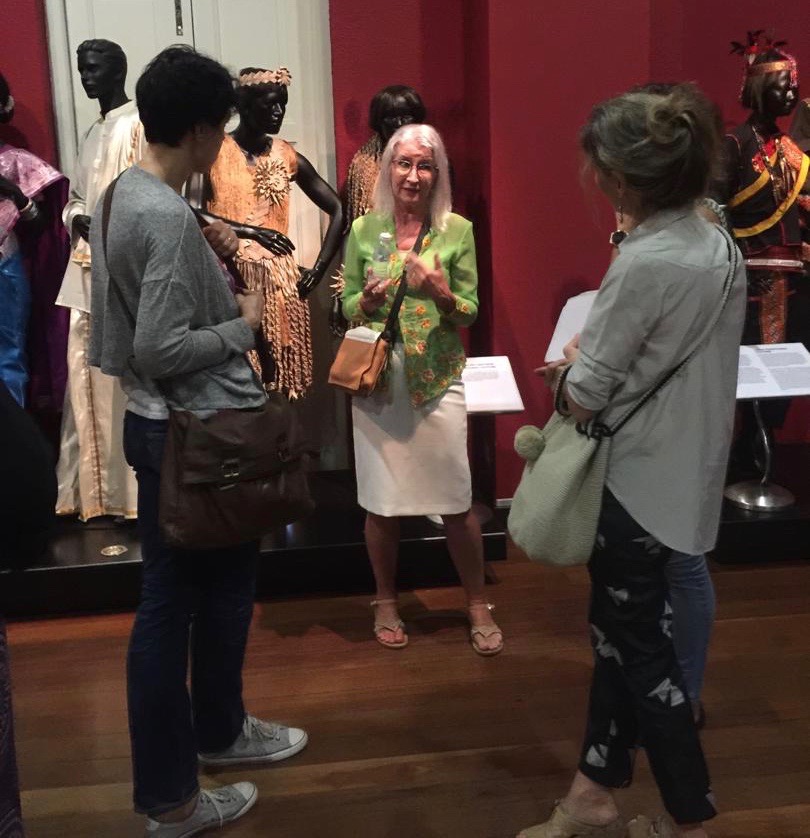|
“… a really nice little museum…”
Like many museums that I have visited over the years, my fascination often begins with the building itself. The National Textile Museum was no different. It sits at the end of a whole row of little gems, relics of colonial architecture capturing Islamic, Malay, English and Indian influences and is rightly so a significant heritage landmark in KL in and of itself. |
||
 |
 |
 |
|
But our MCG tour was to take us within the walls of this magnificent historical building to the magical stories woven into the rich history of the Malaysian textiles industry. It is with great thanks and heartfelt gratitude that I would like to acknowledge our competent guides, Rose and Michelle who walked us through each gallery with stories and anecdotes that brought the collection alive.
Our group was split into two sub-groups, one lead by Rose who has a background in history and the other lead by Michelle who I believe is well versed in the technical side of textiles. I was in Rose’s group. Throughout the tour I was on many occasions simply in awe as I listened to Rose explain how historical developments that we all learnt at school influenced the process, production and techniques of the textile industry. I believe Michelle equally captivated her group with her stories and reports of this industry focusing more on a technical perspective. |
||
 |
 |
 |
|
The Museum is divided into four galleries which are all well organised and focus on a different theme with of course a common thread running through them to link them together, no pun intended. The first gallery focuses on the humble beginnings where tree bark, used as a textile was manipulated and teased into simple clothing, often adorned with jewellery featuring beads and teeth - not a wash and wear item for obvious reasons but rather a one-wear-only garment. Such a tragedy for the amount of work invested! Most interestingly this gallery allowed us to experience how the growth in trade contributed to the process and techniques of textile making. We were introduced to a vast array of various techniques used i.e. weaving, gold-embroidery, beading work and batik-making to name but a few. We learnt that the people of Borneo held a wealth of knowledge about weaving often supplementing their garments with beads with a heavy emphasis on the use of beads in the sacred colours, namely red, white, yellow and black. In addition the stunning songket was introduced as was the gold embroidered keringkam as were many others. We were even treated to the dong son drum and how its carvings influenced weaving patterns! Influences of the Indian and Chinese cultures were clearly illustrated through the many creative exhibits. |
||
 |
 |
 |
|
We left the first gallery with a solid foundation of the processes used and the predominant textiles found in this country. We could only admire the beautiful and intricate patterns woven or dyed into fabrics ranging from the simple cotton to the rich and opulent silks as we entered the second gallery.
The second gallery delved into the power of the cloth. Here we learnt that the textile industry belonged to the women of the indigenous people. The patterns were often a product of their dreams with the focus on creating a motif that provided maximum protection and power for the men who wore them as a cloak of safeguard as they went into battle. This gallery also exhibited a selection of garments from the Chinese community including those of the Baba and Nyonya as well as Sarawakian and Sabahan works. The art of Batik making was further explored and left us admiring their clever skills and creativity |
||
 |
 |
 |
|
The third gallery allowed us to experience the evolution of the Malay dress and specifically how it was influenced by the Indian and Arab Muslims. We witnessed the introduction of buttons and high collars, some resembling the popular Nehru jacket often sported in modern India. What I found particularly fascinating was the use of the songket in men’s pants. But the highlight of this gallery was learning about the “bugis" and the British dislike for this group of people - is this how the term “boogey man” came into being!!!
But the essence of this gallery centred on the meaning of the patterns and specifically the importance of interlocking patterns which can be seen as a metaphor for the philosophy behind how the Malay people value community life and its intertwining relationships. |
||
 |
 |
 |
|
The fourth and final gallery showcased a collection of jewellery used throughout the ages ranging from jewellery ( i.e. necklaces, brooches, earrings, bangles) to ornate headdresses to coin belts to intricate boxes. Most interesting were the modesty discs (referred to as chastity covers by Rose) used by young children to cover their private parts and believed to spiritually guard the child against harm. They are believed to originate from the Sulawesi Island of the Bugis tribe. I am very familiar with these pieces not as chastity items but rather as popular pendants for attaching to necklaces. |
||
 |
||
|
With this in mind, I once again thank our well-informed guides as well as all those who attended and made the morning so enjoyable - and pass on a piece of advice from Rose: “…everything has a meaning and often that meaning is very ancient.”
On a final note it is important to recognise the importance of a museum like this one. It plays a crucial role in keeping alive these ancient arts of textile making in our fast paced world of today as well as showcasing the role history played in its development. Kudos to Rose and Michelle for their research, their passion and their desire to pass on their knowledge to us.
Jane Bircher
|
||




